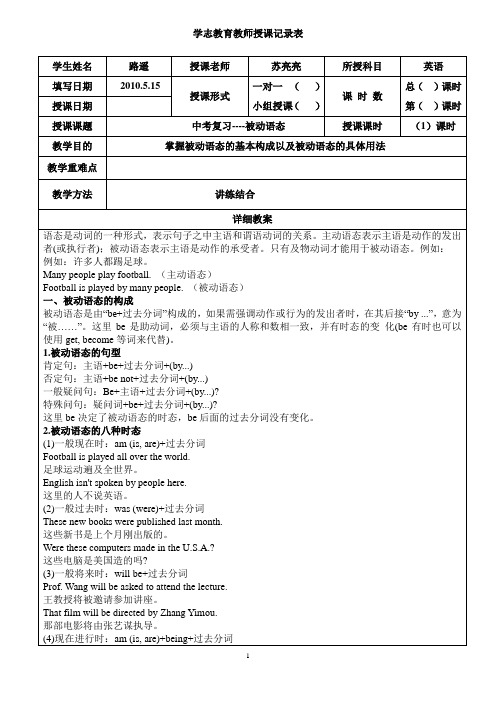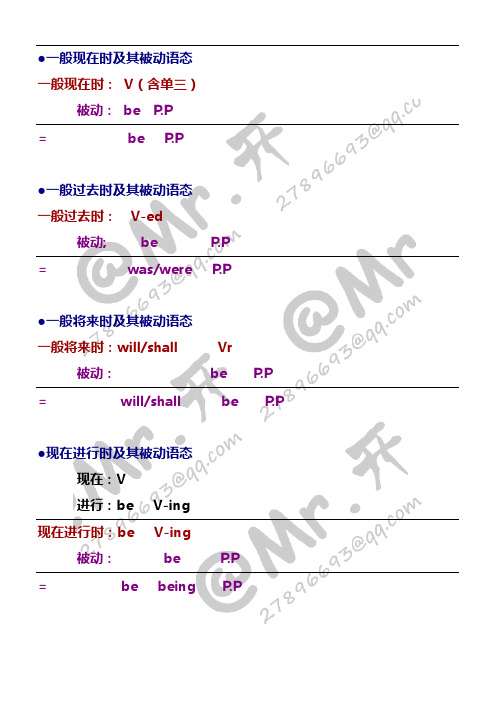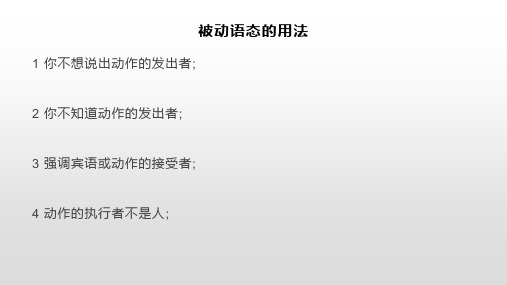各种时态的被动语态举例
- 格式:doc
- 大小:46.00 KB
- 文档页数:4

8种常用时态的被动语态由“助动词be + 动词的过去分词”构成。
助动词be 有时态、人称和数的变化。
(1) 一般现在时:am/is/are +过去分词。
如:Rice is grown in south China. 华南种植水稻。
(2) 一般过去时:was/were+过去分词。
如:The glass was broken yesterday. 这块玻璃是昨天打烂的。
(3) 现在进行时:am/is/are being +过去分词。
如:The project is being carried out. 这个计划正在执行中。
(4) 过去进行时:was/were/being +过去分词。
如:This road was being built this time last year. 这条路去年这个时候还在修建。
(5) 一般将来时:will be +过去分词。
如:The cars will be sent abroad by sea. 这些汽车将由水路运往国外。
(6) 过去将来时:would be +过去分词。
如:The manager said the project would be completed by the end of the year. 经理说这个工程在年底前将会完成。
(7) 现在完成时:have/has been +过去分词。
如:This novel has been translated into several languages. 这本小说已被译成了几种语言。
(8) 过去完在时:had been +过去分词。
如:When I got to the theatre, I found the tickets had already been sold out. 我到达剧院时,发现票已卖完了。
被动语态的主要用法■当不知道或没有必要指出动作的执行者时,常用被动语态,这时往往不用by短语。


一般现在时:V(含单三)被动:be P.P= be P.P●一般过去时及其被动语态一般过去时:V-ed被动; be P.P= was/were P.P●一般将来时及其被动语态一般将来时:will/shall Vr被动:be P.P = will/shall be P.P●现在进行时及其被动语态现在:V进行:be V-ing现在进行时:be V-ing被动:be P.P= be being P.P现在:V完成时:have/has P.P现在完成时:have/has P.P被动:be P.P= have/has been P.P●现在完成进行时及其被动语态现在:V完成:have/has P.P进行:be V-ing现在完成进行时:have/has been V-ing被动:be P.P = have/has been being P.P●过去进行时及其被动语态过去:V-ed进行:be V-ing过去进行时:was/were V-ing被动:be P.P= was/were being P.P过去:V-ed完成:have/has P.P过去完成时:had P.P被动:be P.P= had been P.P●过去完成进行时及其被动语态过去:V-ed完成:have/has P.P进行:be V-ing过去完成进行时:had been V-ing被动:be P.P = had been being P.P●将来进行时及其被动语态将来:will/shall Vr进行:be V-ing将来进行时:will/shall be V-ing被动:be P.P = will/shall be being P.P将来:will/shall Vr完成:have/has P.P---------------------------------------------------------将来完成时:will/shall have P.P被动:be P.P= will/shall have been P.P●将来完成进行时及其被动态将来:will/shall Vr完成; have/has P.P进行:be V-ing将来完成进行时:will/shall have been V-ing被动:be P.P = will have been being P.P●过去将来时及其被动语态过去:V-ed将来:will/would Vr过去将来时:would Vr被动:be P.P= would be P.P●过去将来进行时及其被动语态过去:V-ed将来:will/shall Vr进行:be V-ing过去将来进行时:would be V-ing被动:be P.P= would be being P.P●过去将来完成时及其被动语态过去:V-ed将来:will/shall Vr完成:have/has P.P---------------------------------------------------------过去将来完成时:would have P.P被动:be P.P= would have been P.P●过去将来完成进行时及其被动语态过去时:V-ed将来时:will Vr完成时:have P.P进行时:be V-ing--------------------------------------------------------过去将来完进行时:would have been V-ing被动:be P.P= would have been being P.P。


被动语态被动语态的最基本构成是:be + done(动词的过去分词形式)被动语态和时态是分不开的。
很多时态都有其被动语态形式。
总结如下:1)一般现在时一般现在时主要由动词原形表示,但第三人称单数后要加词尾—s,其方法与名词单数变复数的方法相同。
另外,be和have有特殊的人称形式,be在I后为am;在he,she,it后为is;在we,you,they后为are;have在第三人称单数后为has,在其他人称后仍为have。
被动语态:b e(am/is/are) + done (by)主动语态:Everyone likes her。
被动语态:She is liked by everyone。
2) 现在进行时现在进行时由“be(am/is/are) +现在分词”构成,其否定式是在be后加not,疑问式是将be 提前。
They are building a new school in our village。
She is cleaning the classroom.被动语态:be(am/is/are) being doneA new school is being built in our village。
The classroom is being cleaned (by her)。
3) 现在完成时现在完成时由“have (has)+过去分词"构成。
否定式在have (has)后加not,疑问式将hav e (has)提前.They have built a new school in our village。
I have taught English for 20 years。
被动语态:have/has been + doneA new school has been built in our village.5)一般过去时由动词的过去式表示,其变化是在动词后加—ed,但英语中有大量动词的变化是不规则的,需特别记忆.Tom broke the glass this morning.被动语态:was/were + doneThe glass was broken by Tom this morning。

动词的时态在英语中,由于谓语动作发生的时间不同,或表达不同时间存在的状态,谓语动词都要发生相应的变化.这些动词的形式就叫做动词的时态.英语动词的时态共有16种,列表如下:(以动词write为例)被动语态的构成疑问句时,须将第一个助动词移至主语之前,构成被动语态的否定句时,助动词后须加not. 各个时态的被动形式列表如下:(以动词teach为例)英语被动语态讲解(一)语态的基本概念和种类语态是动词的一种形式,用来表明主语与谓语动词之间的关系。
所以英语的语态是通过动词形式的变化表现出来的。
语态有两种:主动语态和被动语态。
主语是动作的发出者为主动语态;主语是动作的接受者为被动语态。
如:They built the bridge.The bridge was built by them.(二)被动语态的构成被动语态由“助动词be+及物动词的过去分词”构成。
人称、数和时态的变化是通过be的变化表现出来的。
歌诀是:被动语态be字变,过去分词跟后面。
情态动词的被动语态是常考的一个知识点:情态动词+be+过去分词(三)被动语态的用法1)不知道或没有必要说明动作的执行者是谁。
例如:Some new puters were stolen last night.一些新电脑在昨晚被盗了。
(不知道电脑是谁偷的)This book was published in 1981.这本书出版于1981年。
(2)强调动作的承受者,而不强调动作的执行者。
例如:the window was broken by Mike.窗户是迈克打破的。
This book was written by him.这本书是他写的。
Eight hours per day for sleep must be guaranteed.每天8小时睡眠必须得到保证。
(四)主动语态变被动语态的方法与注意事项(1) 通常的办法是:将主动结构中的宾语变为被动结构中的主语,将主动结构中的谓语动词变为“be / get +过去分词”形式,将主动结构中的主语变为介词by的宾语(若动作的执行者没有必要说明则可以省略该by短语)。
动词的时态在英语中,由于谓语动作发生的时间不同,或表达不同时间存在的状态,谓语动词都要发生相应的变化.这些动词的形式就叫做动词的时态.英语动词的时态共有16种,列表如下:(以动词write为例)被动语态的构成一般进行完成完成进行现在writewritesamis writingarehaswrittenhavehasbeen writinghave过去wrote waswrittingwerehad written had been writing将来shallwritewillshallbe writingwillshallhave writtenwillshallhave been writingwill过去将来shouldwritewouldshouldbe writingwouldshouldhave writtenwouldshouldhave been writingwould一般进行完成现在amis taughtareamis being taughtarehasbeen taughthave过去wastaughtwerewasbeing taughtwerehad been taught将来shallbe taught will过去将来shouldbe taught would被动语态由助动词be加过去分词构成,时态通过be表现出来.构成被动语态的一般疑问句时,须将第一个助动词移至主语之前,构成被动语态的否定句时,助动词后须加not. 各个时态的被动形式列表如下:(以动词teach为例)英语被动语态讲解语态的基本概念和种类语态是动词的一种形式,用来表明主语与谓语动词之间的关系。
所以英语的语态是通过动词形式的变化表现出来的。
语态有两种:主动语态和被动语态。
主语是动作的发出者为主动语态;主语是动作的接受者为被动语态。
如:They built the bridge.The bridge was built by them.(二)被动语态的构成被动语态由“助动词be+及物动词的过去分词”构成。
不同时态下的被动语态在英语语法中,被动语态是一个重要的概念。
它用于强调动作的承受者,或者当我们不知道动作的执行者是谁时使用。
被动语态在不同的时态中有不同的形式和用法,下面我们就来详细探讨一下。
一般现在时的被动语态,其构成是“am/is/are +过去分词”。
例如,“The book is read by many people”(这本书被很多人读。
)在这个句子中,“is read”就是一般现在时的被动语态形式,表示“书”是“被读”的这个动作的承受者。
再比如,“Rice is grown in many countries”(水稻在很多国家被种植。
)“is grown”体现了“水稻”被种植的情况。
一般过去时的被动语态,结构为“was/were +过去分词”。
比如说,“The bridge was built last year”(这座桥是去年被建造的。
)“was built”清晰地表明了“桥”在过去的某个时间被建造的事实。
“The trees were planted by the students”(这些树是学生们种的。
)这里的“were planted”则反映出“树”是过去被学生种植的。
一般将来时的被动语态是“will be +过去分词”或者“be going to be +过去分词”。
像“The sports meeting will be held next week”(运动会将在下周举行。
)“will be held”表示运动会在未来会被举行。
“A new factory is going to be built here”(这里将要建一座新工厂。
)“is going to be built”也展现了未来将要发生的被动动作。
现在进行时的被动语态为“am/is/are + being +过去分词”。
例如,“The problem is being discussed by them now”(这个问题正在被他们讨论。
在英语中,由于谓语动作发生的时间不同,或表达不同时间存在的状态,谓语动词都要发生相应的变化.这些动词的形式就叫做动词的时态.英语动词的时态共有16种,列表如下:(以动词write为例)被动语态的构成构成被动语态的一.时态通过be表现出来被动语态由助动词be加过去分词构成,助动词,须将第一个助动词移至主语之前,构成被动语态的否定句时般疑问句时,)teach为例后须加not. 各个时态的被动形式列表如下:(以动词英语被动语态讲解(一)语态的基本概念和种类语态是动词的一种形式,用来表明主语与谓语动词之间的关系。
所以英语的语态是通过动词形式的变化表现出来的。
语态有两种:主动语态和被动语态。
主语是动作的发出者为主动语态;主语是动作的接受者为被动语态。
They built the bridge. 如:The bridge was built by them.)被动语态的构成(二+及物动词的过去分词”构成。
人称、数和时态的变化是被动语态由“助动词be 的变化表现出来的。
通过be 字变,过去分词跟后面。
歌诀是:被动语态be 过去分词情态动词的被动语态是常考的一个知识点:情态动词+be+ 被动语态的用法三)( 例如:1)不知道或没有必要说明动作的执行者是谁。
一些新电脑在昨晚被盗了。
Some new computers were stolen last night. )不知道电脑是谁偷的( 1981年。
This book was published in 1981. 这本书出版于强调动作的承受者,而不强调动作的执行者。
例如:(2) 窗户是迈克打破的。
the window was broken by Mike.This book was written by him. 这本书是他写的。
Eight hours per day for sleep must be guaranteed. 每天8小时睡眠必须得到保证。
各种时态的被动语态举例(以动词do为例) 1.一般现在时(am/ is/ are +done) English is spoken by lots of people in the world. 世界上的许多人都说英语。 Class meeting is held every Thursday. 每周四都举行班会。 The classroom is cleaned by the students every day. 学生们每天都打扫教室。
2.一般过去时(was/ were +done) The cup was broken by the boy. 杯子被那个男孩打碎了。 He was saved at last. 他最终获救了。 My bike was stolen. 我的自行车被偷了。 3.一般将来时与过去将来时(will/ shall be +done; would/should be +done) A speech will be given this afternoon. 今天下午有一个演讲。 A new road will be built next year. 明年要修一条新马路。 I thought thousands of people would be helped. 我认为将有数千人得到帮助。
4.现在进行时与过去进行时(am/ is/ are being +done; was/ were being +done)
The machine was being repaired at this time yesterday. 昨天这时,机器正在被修理。
The problem is being discussed now. 问题正在被讨论。 A bus is being pushed by the passengers. 路人正在推一辆公共汽车。 5.现在完成时(have/ has been + done) Two hundred trees have been planted by now. 到现在为止,已经种了二百棵树了。
The book has been read many times by me. 这本书已经被我读了许多遍了。 6.过去完成时(had been+done) They said they had been invited to the party. 他们说已经被邀请参加晚会了。
She found the house had been destroyed by the storm. 她发现房子已经被暴风雨摧毁。 He had been tortured by the illness for many years before he died. 他在去世前已经被疾病折磨很多年了。 7.含有情态动词的被动语态 情态动词的被动语态结构为:情态动词+be+过去分词;其时态及句型的变化仅由情态动词完成,"be+过去分词"部分不变。如: Tables can be made of stone.桌子可由石头制造。 Tables could be made of stone at that time. 那时桌子可由石头制造。(一般过去时)
Can tables be made of stone? 桌子能用石头制造吗?(疑问句)
动词的主动形式表示被动之意 系动词无被动语态:以主动形式表示被动之意 常见的系动词有:
① be动词 ② ……起来(7个):look/seem/appear, feel(感觉,摸起来), sound, smell, taste e.g. She seems/appears happy. It smells terrible. ③ (逐渐)变得/变成:become, grow, get, turn, come, go e.g. His wish has come true. People often went hungry in the old days. The tree is growing tall.
④ 保持:keep, stay e.g. We must keep quiet in the reading room.
下列动词(词组)没有被动式: 1、happen, take place, break out, belong to 2、不及物动词sell, wash, read , write,等,常用主动形式表示被动意义。 ○1、An accident was happened yesterday.(×)昨天发生了一起事故。 An accident happened yesterday. ○2、The flower smells sweet.这花闻起来很香。 ○3、The watch looks good.这表看起来很好。 ○4、This book sells well.这本书畅销。 ○5、The kind of cloth washes well. 这种布很容易洗。 ○6、The article reads well. 这篇文章读起来很好。
被动语态专项练习 Ⅰ单项选择 1. Good books ____ again and again. A. should be readed B. should be read C. must read D. ought to read 2. The children ____ by the nurse. A. were looked B. looked after C. were looked after D. looked 3. He ___ some pieces of advice, but he ____ to them. A. gave, didn't listen B. was given, wasn't listened C. give, wasn't listened D. was given, didn't listen 4. When____ the accident _____ ? A. was, happen B. did, happen C. is, happen D. was, happened 5. The question ____ by us soon. A. is going to discuss B. will discuss C. is going to be discussed D. has been discussed 6. The lab ____ about five years ago. A. was builded B. was built C. builds D. has been built 7. A lot of tall buildings _____ in his hometown in the last three years. A. have set up B. have been set up C. were set up D. set up 8. They ____ printing 500 copies by the end of last month. A. had finished B. have finished C. had been finished D. have been finished 9. Rice ___ also _____ in their hometown. A. is…grown B. is…grew C. was…grew D. was…grown 10. He ____ by the teachers. A. is always praised B. praises C. have been praised D. always is praised 11. Great changes ____ place. Many new schools____ . A. have taken, have been opened B. take, are open C. are taken, open D. have been taken, are opened 12. The picture______ in October, 1996. A. was taking B. had been taken C. was taken D. had taken 13. We can't use the bridge now, because it______ . A. has been repaired B. is repairing C. is repaired D. is being repaired 14. I ______the way to the railway station by a policeman. A. was shown B. showed C. have shown D. was showing 15. The war______ in 1941. A. broke out B. had been broken out C. was broken out D. had broken out 16. When water______ , it will be changed into vapor(蒸汽). A. is heated B. heating C. has heated D. heats 17. We can't enter the room because its door______ . A. locked B. locks C. is locked D. is locking 18. They ______day and night. A. are made work B. are made to work C. made to be worked D. are making to work 19. Chang'an Road is ______of people. A. filled B. fill C. full D. fulled 20. Man-made satellites ______into space by many countries. A. was sent up B. is sent up C. have been sent up D. has been sent up